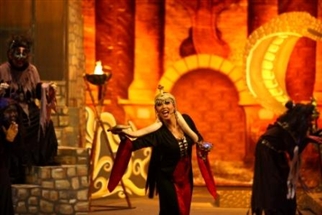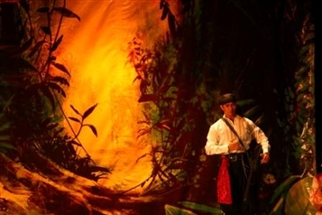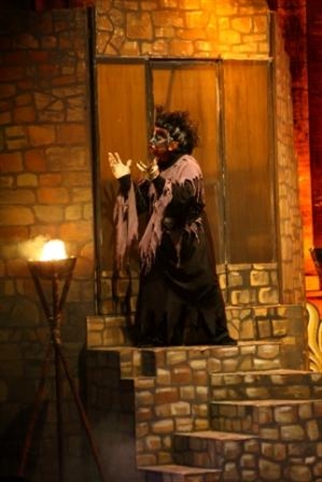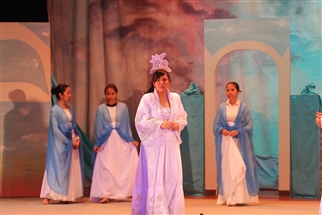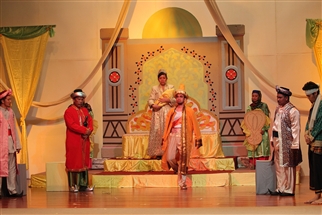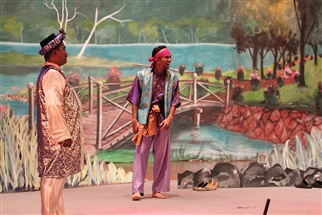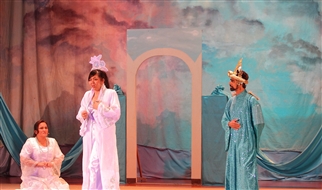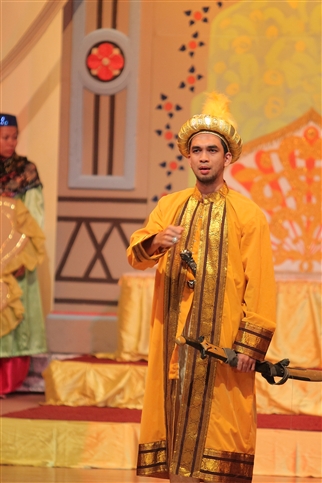
Text and Language
The stories that are performed by Bangsawan are derived from various sources including stories from local history, contemporary stories, stories from the Middle East, India, China, Indonesia, Thailand and the west. These variety is due to the desire of the Bangsawan group to fulfil the taste of a multiracial audience. Although the stories are different and originated from different culture, the medium of language is always the Malay language.
Text:
1. Stories of Local history
The stories are about the greatness of kings, biographies of local leaders and Malay heroic figures are among the themes features. Normally, the reprisal, adventure, romance, battle, misinterpretation, heroism, the injustice were among the themes featured in this story. These story would include elements of delusion, full supernatural power and strength. Among the popular stories that are classifed under the segment of local history are Hang Tuah, Si Badang, Sultan Mahmud Mangkat Di Julang, Dandan Setia, Laksamana Mati Dibunuh, Laksamana Bentan, Jula Juli Bintang Tujuh. Jula Juli Bintang Tiga, Megat Terawis, Megat Terawih, Lembing Awang Pulang Ke Dayang, Puteri Wanang Sari, Bidasari, Dadida, Puteri Gunung Ledang, Sirih Bertepuk Pinang Menari, Nujum Pak Belalang, Malim dewa, Malim Deman, Singapura di Langgar Todak, Puteri Lindungan Bulan and others.
2. Stories from India
Before the arrival of Islam to the Malay Archipelago in the early 15th century, the Indian in Malaysia embraced and practised the Hindu religion and culture. This adherence and practice are still very much in practice although the Islamic religion has taken root. With these matters in place, it is no wonder that the Malay community accepts and are interested in stories from India. By accident the Persian theatre which was brought into the Malay world before the existence of Bangsawan. All stories performed by these Persian Theatre were based from sources taken in India. Hawa-i-Majlis, Ali Chandran, Gul Bakawali, Hikayat Bistamam, Sukarjit are Bangsawan stories that originated from India and are still popular among audience. Stories that are romantic in nature are well-liked by the audience. Many of these stories from India, were based or inspired by Islam. Among the stories very widely presented by Bangsawan were Phar Ki Putli, Indera Saba, Bawafa Khatil, Cintamani, Roman Diroba, Haris Chandra, Izazam Khalbi, Sakuntala, Gulzr E-Neky and many more.
3. Middle East Stories
Stories from Middle East were also used. Story from the Middle East were also used. Stories from the Middle East became popular choices in a Bangsawan performance as it did not dwell into matters of the Islamic religion but more towards the elements of adventure and romance. Aladin with the Magical Lamp, Ali Baba and the forty thieves, Laila Majnun, Yatim Mustaffa, Jula Juli Bintang Tiga, Jula Juli Bintang Tujuh, Tajul Muluk are among the stories well-liked by the audience
Other stories that were performed regularly are Sinbad, Taman Balkis, Musalmah Pintu, Sheikh Arabi, Bayan Budiman, Garden of Khamah, Siti Nurul Banun, Gadis Malang, Askia Asidah, Khuri Arab, Nur E-Isalm, Nur Affendi, Rahsia Kubur Keramat and many more. Its story, costume, rhythm of the song and dance are the factors that stimulate the fans' interest.
4. Stories from China
The stories from China are also found in the Bangsawan. These Bangsawan groups held their performances in the urban areas such as Ipoh and Kuala Lumpur, where there is a significance population belonging to the Chinese ethnic group. Among the popular stories used are Siti Zubaidah, Sampit Ng Tai, or Sam Pek Eng Tai, Busiong Sichap Cho, Gu Seong Sat So, Si Jin Kui, Li Mooi Kuan, Panglima Ah Chong, and others were frequently performed. These stories were usually performed in areas where there are larger Chinese population density.
5. Stories from the West
Under the colonial rule of the British, the Malay Peninsula were flooded with the Western theatre like the opera and vaudeville. This form of theatre received reception from the local audience. The effect of the arrival of the theatre stimulated the Bangsawan groups to adapt the popular stories from the West and to serve it to the local audience. The Bangsawan group of the Malay Peninsula would choose the more popular stories to be performed. Among these stories that are performed include Othello, Hamlet, Romeo dan Juliet, Jeneral Fipa atau Gino Fipa, Macbeth, Merchant of Venice, Cinderlela, Dragon Blood, Naga Berapi, Dr Faust, Black Eagle, Minda Mora, Air Mata Spain, Topeng Hitam. Topeng Perak.
6. Stories from Indonesia, Thailand and Burma
The centuries of relationship between Malaysia and Indonesia has resulted in a close similarity of the culture of the Malays in both countries. The usage of common language allows many stories from Indonesia to enjoy good reception peninsula. In fact, there were theatre groups from Indonesia with their Stambul Comedy theatre coming here to perform in the Malay Peninsula. Likewise, the Bangsawan theatre group also travelled to Indonesia to perform. Very often, the stories which were brought by the Bangsawan groups and those that are well received by the audience are Panji Jaya Asmara, Panji Semerang, Songgeng, Gelenggong, Sang Sembah, Ken Tambuhan, Cindromato, Andai Andai Lumut, Gagak Solo and Siti Bakheram.
Stories from Thailand and Burma were also brought in and adapted to the Bangsawan. Among them are Puteri Timun Muda dan Maharani from Thailand, and Hamru, Rose from Burma.
7. Modern Stories
As it was told, Bangsawan stories tries to fulfil the community's taste. In the early 1930s, congruent to the community development and its era, many stories performed were not related to the fantasy world. These stories started to approach the world of realism although with Bangsawan characteristics. The stories of this era were categorised as modern stories. Kembang Kenanga Dari Kota, Dua Puluh Lima Tahun Dalam Rahsia, Nyai Dashima, Nyai Shaminah, Pak Dol Keropok, Melati Fan Agam, Bengawan Solo, Siti Anbhari, Siti Nurbaya, Kacang Lupa Kulit, Selendang Sutera, Jambatan Merah, Nyak Putih, Oh Darjat, Nyak Intan, Air Mata Kasih, Terang Bulan, Celorong Celoreng, Muslamah, Baktum Baktim, Teruna Kampung were among the stories. These modern stories did not enter the world of the palace but revolved around the common society.
Language
Most of the Bangsawan stories revolves around the palace area and the upper class or the nobility. These circumstances causes the actors to speak and dialogue using the royal language which are flowery and full of customs. This form of language poses difficulty to the audience as speeches sounded unrealistic, in a non-conversational character. Clear articulation and effective projection of the voice are often practised by Bangsawan actors. According to the views of Bangsawan activists, the use of daily and conventional language will deplete the essence of the original Bangsawan character.
With regards to the use of language, the Malay Riau language was used. It was assumed that the Malay Riau language was more refined and soft portraying the characteristics of Bangsawan. The standard language was opined to be harsh, hard and too colloquial and did not display the characteristics of the nobility class. The poetic language is mandatory in Bangsawan. Various types of poems such as syair, gurindam, pantun, seloka were the practice in Bangsawan, especially in the palace stories.
1. Pantun (rhyming quatrain with inner assonance)
The Bangsawan stories which has elements of local stories could not avoid the use of pantun. Pantun are used during moments of affections, joking, prank or ensues. Here we could see the display of the actor's skill in the selling and buying of the quatrain through improvisation.
2. 'Bernasib'
Almost all Bangsawan stories displays scenes of 'bernasib'. 'Bernasib' reflects the emotion of the characters who experience conflict and who express those feelings in the midst of a conflict through chosen words that are sung. Poetic words that are sung are performed solo by the character who is bearing the suffering. There is music accompaniment for the actor who is experiencing 'bernasib'. The choice of songs that accompanied the actor are usually based on original rhythm. The emotional moments in 'bernasib' are like separations, sufferings, failure in love, moments of death and appeal for sympathy. The aim is to get sympathy from both the actors and the audience. The method of the presentation used is by interspersing the spoken dialogues with the words that are sung.
3. Poems
Besides the gurindam (couplets) and Pantun (rhyming quatrain with inner assonance) , poems are recited in a few chosen stories. The role of poems as a story opener and as a dialogue that are recited as a poem is similar to the attracting of luck. During the sad scenes, attracting luck through poem recitation is most often conducted. As poem is sung, there would be music accompaniment. Poems that are used to attract luck was a little different from regular poems. In the regular poems, the final syllable of every line have similar sounds but in the poem to attract luck, the artistic creation of words are the dialogues uttered in poetic recitation.
4. Aside (loud whispering) and soliloquy
Loud whispering or 'aside', and soliloquy are practices used in Bangsawan. Aside or loud whispering are the utterances where the character exposes directly his thoughts or the thoughts of the writer/director to the audience regarding the actions, feelings or about the other characters who are on stage. These utterances are aimed directly at the audience and the other actors ’pretends’ not to hear it. Aside or loud whispering are the comments that are delivered for the importance of the audience. In Bangsawan, aside or loud whispering are usually made by the comedian who would make these comments to arouse a funny feeling or laughter among the audience.
5. Soliloquy
There is little difference between soliloquy and loud whispering. Soliloquy is not delivered directly to the audience. Soliloquy aimed to provide an opportunity to the audience to listen to the thoughts or the ability of thoughts which plays around or revolving around the mind of the character. Generally soliloquy is carried out by an actor who is on stage. The spoken content includes voices from his heart, inner emotions and his present thoughts. In Bangsawan the soliloquy scene is usually exhibited in stage.
From the aspect of acting, the character who is alone presents a soliloquy that could move freely using the acting space on stage. From the aspect of action, the character is free to ’play around’ with his emotions. Usually in this scene, the actor would use the opportunity as much as possible so as to leave an impact of himself. The actor is also aware that in the scene, all the actors would focus on him which is an awaited opportunity to successfully play his role.
6. Monologue
Besides the technique of loud whispering, the monologue technique is also used in Bangsawan. The monologue, self-utterances is aimed at a person, whether it be the audience or the imaginative second character. Sometimes this term overlaps the meaning of soliloquy. Soliloquy, although meant talking to oneself involves utterances that are about one's thoughts. On the other hand the monologue is aimed at announcing these thought the audience on what is happening. At times this method could receive the response from the audience, whether it be negative or positive. These reponses would not influence him.
For example, in the Tok Mahat story, the actor talks to himself after he was insulted by the Sultan. In such a situation, it all depends on the content of the utterances which are improvised regardless of whether he was speaking out his thoughts (soliloquy) or talking to the audience about the sultan insults towards him (monologue).
.jpg&width=322)
.jpg&width=322)
